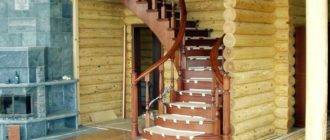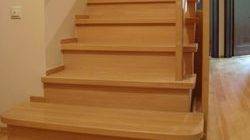The question of how to paint a wooden staircase correctly is of interest to many. Of course, painting work does not require special qualifications, but you want everything to be perfect!
And there are several nuances in painting stairs, and we will talk about them in our article.
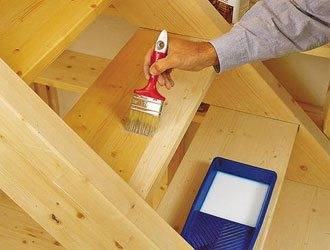
Approach to work
Painting requirements
Before proceeding with the dilution and application of paints, you need to decide what result we want to achieve. This will help us choose the right paint itself and the equipment for its application.
What should be taken into account:
- If we want the wooden staircase to retain its texture after painting, then it is worth abandoning primers, and choosing paint with a relatively low hiding power.
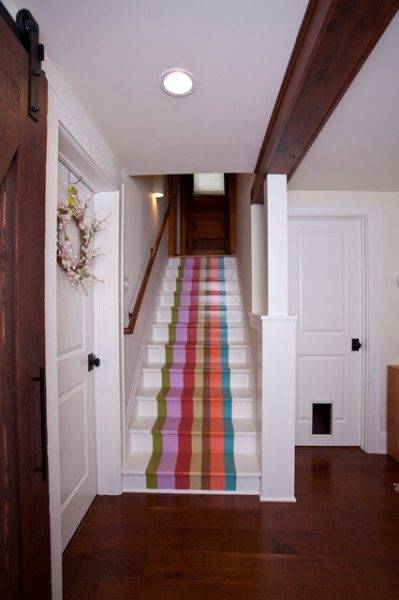
- You can also use matte or glossy wood varnish instead of paint to preserve the wood grain. It can be both transparent and tinted, so varnishing makes it possible to significantly change the appearance of the stairs.
- If we paint indoors, then it is worth choosing compounds that dry quickly enough and get rid of the unpleasant odor.

- For outdoor use, other paints are quite suitable: more resistant, but smelling of solvent for some time.
- The steps must be treated with a composition that will resist abrasion for as long as possible. Otherwise, in a month, ugly scuffs will appear on a fresh layer of paint.
By the way, it is worth noting that in addition to the aesthetic function, good paint should fulfill the task of protecting the wooden parts of the stairs from external influences. Of course, this is more important for outdoor stairs, but inside the house it is worth protecting the wood from moisture, dust, dirt, etc.
What to paint
From the above, the question naturally follows - how to paint a wooden staircase in a house?
Here, the choice of options is quite large, ranging from specialized formulations from world-famous manufacturers, and ending with artisanal paint and varnish mixtures:
- Paints... It is best to use special grades designed specifically for woodworking for processing stairs. The market leaders in this case are alkyd and urethane-alkyd compounds. The former fit well on any surface, while the latter can be used for re-painting.
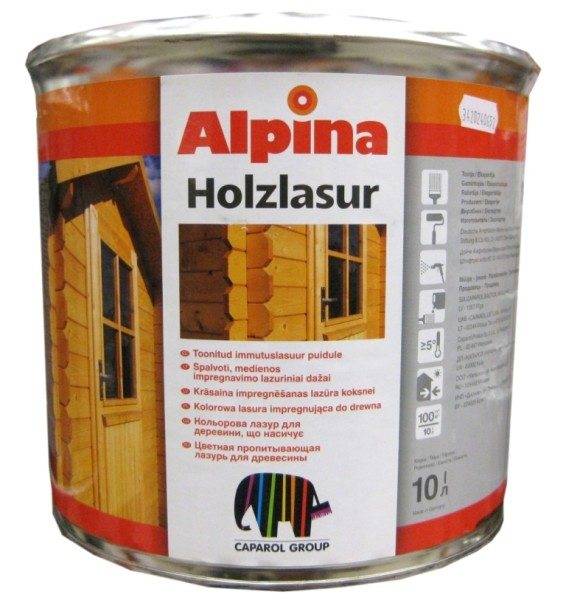
- Examples of the most sought after brands are Tikkurila Empire, Pesto, Betolux and many others.
Advice!
The range of colors can be varied, ranging from natural wood shades to pure bright colors.
When choosing a shade, it is necessary to take into account the stylistic solution of the room in which the staircase is located, and the whole house as a whole.
- Enamel compositions provide not only decor, but also protection of the wooden base. Due to the formation of a dense film on the surface, the enamel minimizes the effects of moisture, ultraviolet radiation, high temperatures, etc. The base of the enamel is a colorless varnish, to which a special pigment for wood is added.
- For the treatment of stairs inside the house, enamel mixtures are suitable, characterized by a high drying rate. As examples, we can recommend the products of Sirca (Italy) or Synteko (Sweden). The price of these enamels is quite high, but they do not contain toxins and therefore can be used in any premises.
- Lucky... Unlike paints and enamels, varnishes mainly emphasize the natural color and texture of the surface of the natural wood from which the steps and railings are made. Of course, pigments can be added to the composition of varnishes, but they rather perform a toning rather than a coloring function.
- Stairs in the house should be treated with alcohol-based varnishes. For outdoor work, nitrocellulose compounds are suitable, which contain hardeners and plasticizers. A nitrocellulose-based coating will be more durable and resistant to temperature changes.
- Impregnations and stains - This is another group of compounds that is used for the treatment of wooden stairs. With their help, wood is tinted, in addition, they can have a fire and bioprotective effect.

At the final stage, experts recommend covering the stairs with polish - a composition that ensures the gloss and durability of the surface. The choice of polish depends on what kind of paint or varnish was used to treat the wood.
Work technology
Wood to wood - strife
If you contact a specialized company to find out the cost of painting a wooden staircase, you will be unpleasantly surprised at a fairly solid amount. That is why many of our compatriots have a desire to do the work with their own hands - especially since it does not present any particular difficulty.
First, you need to pay close attention to the wood from which the staircase is made:
- Conifers (spruce, pine, cedar) are distinguished by a high content of resinous substances, and therefore the paint on them holds somewhat worse.
- Hardwoods are characterized by sufficient density, and therefore it is easier to prepare them for painting.
- Fresh wood has a large number of open pores, which leads to abundant absorption of liquid components of varnishes and enamels.
- Old and dense wood should be primed with high quality, otherwise the paint will simply flow down the stairs.
Preparing the stairs for painting
In any case, in order for the paint to lie flat and hold securely, the stairs must be carefully prepared:
- At the first stage, we fill in all the cracks with putty into which the paint can flow. For best results, use a special wood mixture. (see also Oak stairs - manufacturing and assembly features)
Advice!
So that the putty spots are not visible through the varnish, its shade should be selected as close as possible to the color of the wood.
- After the mixture has dried, we clean the filler with sandpaper in such a way that a perfectly flat surface is obtained.
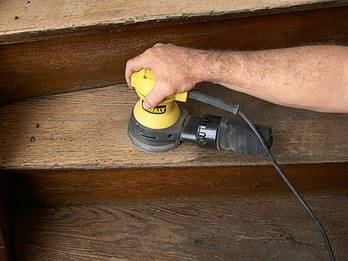
- Ideally, wait two to three days after the first resurfacing, and then repeat the operation. This will ensure the most complete polymerization of the putty mass.
- After finishing the treatment, we remove dust from the surface, since even the smallest sawdust under a layer of paint or varnish will appear very prominently.
- We prime the stairs with a brush or roller, applying the primer twice with a break of 24 hours.

Painting the stairs
Painting of wooden stairs begins after the second layer of primer is completely dry.
Before starting work, mix the paint thoroughly or dilute the tinting component in a transparent varnish (how to do this - the instructions from the manufacturer will tell you).

To apply the paint composition, you can use:
- Brushes - wide, with natural or artificial bristles.
- Rollers.
- Sprayers for paint.
- Spray guns.

Below are some tips for using the brush, as this method is the most accessible:
- We start painting from the largest areas in terms of area - railings, steps, stringers, etc. It is also worth moving from top to bottom, making sure that the flowing paint does not freeze in drops.
- Take a small amount of paint on the brush. We remove the excess by running a brush either along the edge of the can, or along an elastic band specially stretched over the neck.
- Holding the brush at an angle of about 450 to the surface to be painted, evenly distribute the paint or varnish.
- For the highest quality coating, you can apply from 2-3 to 5-6 layers. We put each next layer only after the previous one is completely dry.
- When using tinted varnish, apply the darkest mixture to the wooden base. We make the upper layers of the staircase varnish almost transparent - this will give the stairs depth and emphasize the texture of the wood.

The paint should dry at room temperature and normal humidity. Heat or cold will lead to the appearance of microcracks on the surface of the stairs, which will very soon expand and cause the paint to peel off.
Output
We hope that thanks to the information presented in the article, you have learned how to paint a wooden staircase as efficiently as possible. (see also Single-flight staircase: a simple solution) Believe me, such work does not present any particular difficulties, and if you do not rush, then very soon the steps in the house will shine with fresh colors or acquire a noble shine of varnish. In the video presented in this article, you will find additional information on this topic.



